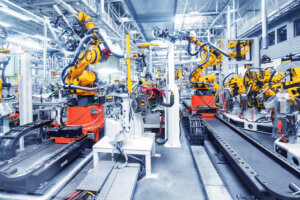In our previous blog posts, we reviewed what concurrent engineering is, why you need it, and how to implement it within your organization. Advanced concurrent engineering solutions, such as CAD and PLM, allow you to automatically communicate product changes to stakeholders. Ultimately, improving communication efficiency allows everyone to work in parallel to create better products faster.
Concurrent engineering sounds like an ideal solution—especially for distributed teams—but how are top organizations getting the most benefit from it? Let’s dive in.
Concurrent Engineering Example #1: Using CAD in Manufacturing
Manufacturing organizations today must be able to create products rapidly to stay competitive. The key to making this possible is speeding up the evaluation of design and manufacturing process alternatives. Computer-aided design (CAD) helps manufacturing organizations create innovative products quickly with advanced and efficient manufacturing technologies.
CAD is the driver behind numerous innovative product design techniques:
- Generative design uses the power of modern 3D modeling technology and computer programming to create and optimize designs using an iterative approach.
- Simulation helps designers understand precisely how products will work within the parameters of real-world stressors such as airflow, temperature, and more.
- Multi-body design simplifies the creation of designs when working with complex geometries by allowing users to work freely with disjointed and overlapping components on a single part.
Concurrent engineering using CAD technology allows teams to efficiently take products from concept to digital prototype.
Concurrent Engineering Example #2: BOM Management
Advanced bill of materials (BOM) management, transformation, and traceability help teams create and manage configurations using a part-centric approach. This method can benefit the entire product lifecycle with mechanical, software, and electronic parts and artifacts integrated into the complete engineering BOM. In addition, the BOM acts as the single source of truth that improves collaboration between teams and their supporting software such as CAD, PLM, and ERP. Lastly, this improves overall traceability and streamlines long-term BOM reconciliation with MBOM associativity and unified change processes throughout product development.

Concurrent Engineering Example #3: Process Planning
Implementing PLM solutions also supports concurrent engineering initiatives. Using PLM, MBOMs and process plans get all teams on the same page regarding how a product is assembled. Plus, PLM helps reduce time to market by empowering designers to use previous designs and parts. Manufacturing performance becomes seamless as support for change workflows is integrated across the product lifecycle.
Concurrent Engineering Example #4: Resource Management
PLM uses manufacturing resources more efficiently by making them readily available on the shop floor for the maintenance, inspection, or repair of parts. PLM offers up a single source of truth for all product data, whether the resources needed are physical materials or human skills. This reduces the cost, time, and technical constraints typically associated with those resources.
Concurrent Engineering Example #5: Assembly Instructions
Frontline workers are empowered by access to PLM’s central repository of information. These teams can retrieve the most relevant and up-to-date assembly work instructions—without having to search through versions or contact other teams for verification. Using PLM software, engineering can easily define the necessary processes and specific materials, as well as the tools, skills, and parts needed to complete the work. This, coupled with CAD resources like 3D illustrations and animations, can further contribute to the central repository so assembly instructions can be as complete as possible.
Combining the power of PLM and CAD gives frontline workers all the information they need to plan for and put together final assemblies.
Get Started with Concurrent Engineering
With concurrent engineering, product development teams can easily communicate any information associated with a product—and this technique is powered by advanced CAD and PLM solutions. Platforms such as Creo CAD and Windchill PLM weave product data together so steps can be completed simultaneously rather than sequentially for maximum efficiency.
Ready to get started with concurrent engineering? Contact us—our team can help you determine if you have the right solutions to implement this new strategy, and we can help you choose new solutions if needed.
